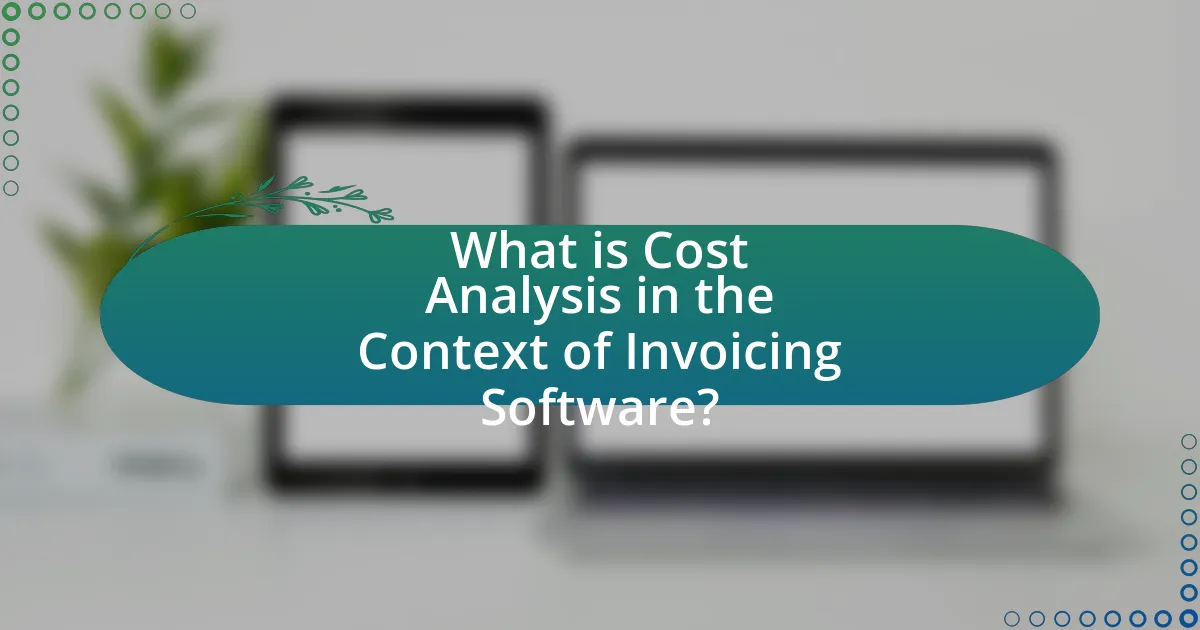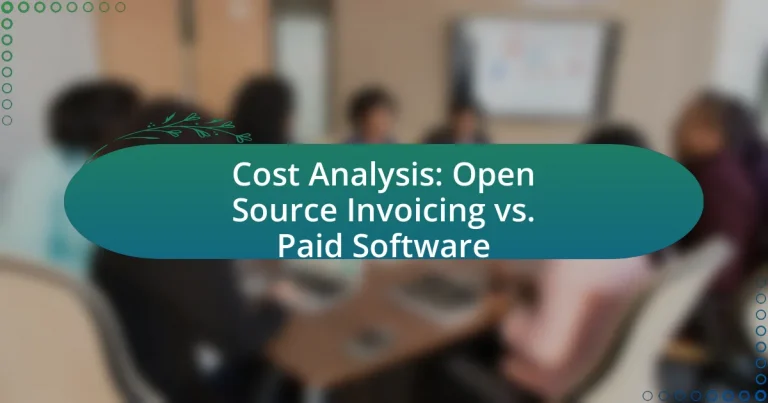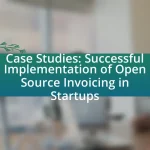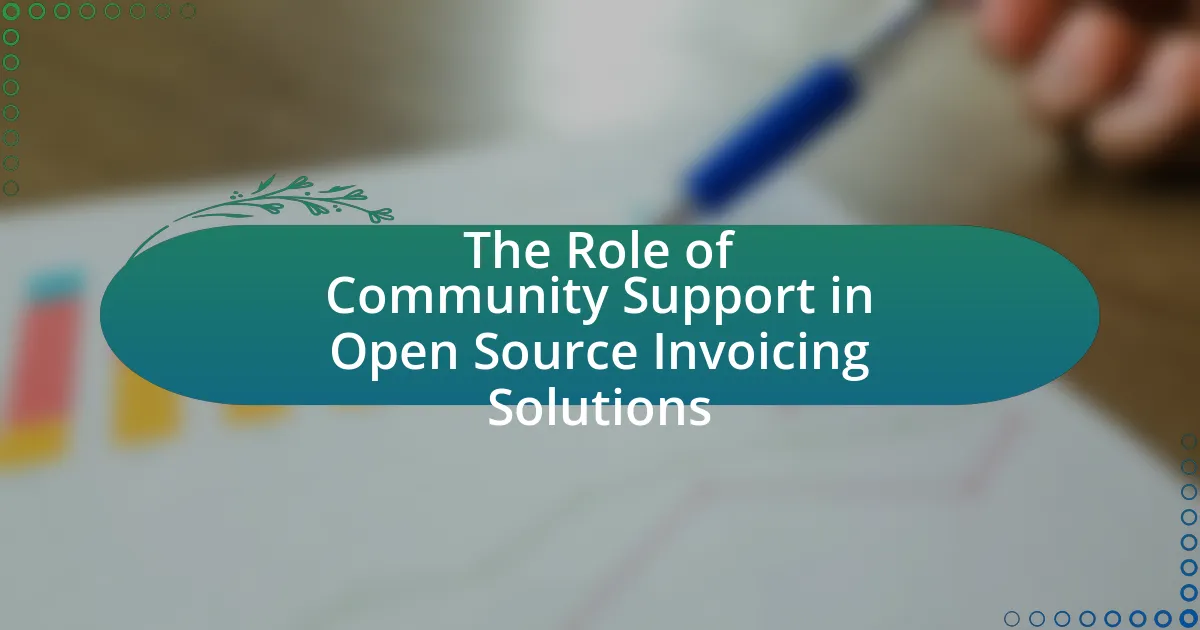Cost analysis in the context of invoicing software involves evaluating the costs associated with both open-source and paid software solutions, helping businesses determine their total cost of ownership. The article compares the financial implications of open-source and paid invoicing software, highlighting key features, hidden costs, and the importance of cost analysis in financial decision-making. It discusses factors influencing software costs, the components of total cost of ownership, and best practices for conducting cost analysis, ultimately guiding organizations in selecting the most suitable invoicing solution for their operational needs and budget constraints.

What is Cost Analysis in the Context of Invoicing Software?
Cost analysis in the context of invoicing software refers to the systematic evaluation of the costs associated with using different invoicing solutions, including both open-source and paid software options. This analysis helps businesses determine the total cost of ownership, which includes initial purchase or subscription fees, ongoing maintenance, support costs, and any additional expenses related to implementation and training. By comparing these costs, organizations can make informed decisions about which invoicing software best fits their budget and operational needs, ultimately leading to more efficient financial management.
How do Open Source Invoicing Solutions Compare to Paid Software?
Open source invoicing solutions typically offer lower upfront costs compared to paid software, as they are often free to use and modify. This cost advantage arises because open source software does not require licensing fees, allowing businesses to allocate resources elsewhere. However, while open source solutions can save money initially, they may incur additional costs related to customization, maintenance, and support, which are often provided by third-party vendors or require in-house expertise. In contrast, paid software usually includes customer support and regular updates, which can enhance usability and reduce long-term operational costs. According to a 2021 survey by Capterra, 60% of small businesses reported that they preferred paid software for its reliability and support, highlighting the trade-off between initial cost savings and ongoing service quality.
What are the key features of Open Source Invoicing Software?
Open Source Invoicing Software typically includes features such as customizable invoice templates, multi-currency support, expense tracking, and integration with payment gateways. These features allow users to tailor invoices to their branding, manage transactions in various currencies, track expenses efficiently, and facilitate online payments. Additionally, many open source solutions offer user access controls, reporting and analytics tools, and the ability to automate recurring invoices, enhancing overall financial management. The flexibility and adaptability of open source software are further supported by community contributions, which can lead to continuous improvements and updates.
What are the key features of Paid Invoicing Software?
Paid invoicing software typically includes features such as automated billing, customizable invoice templates, payment tracking, and integration with accounting systems. Automated billing allows businesses to schedule recurring invoices, reducing manual effort and ensuring timely payments. Customizable invoice templates enable users to create professional-looking invoices that reflect their brand. Payment tracking features provide real-time updates on invoice status, helping businesses manage cash flow effectively. Integration with accounting systems streamlines financial management by synchronizing invoicing data with overall financial records, enhancing accuracy and efficiency. These features collectively improve the invoicing process, making it more efficient and user-friendly for businesses.
Why is Cost Analysis Important for Businesses?
Cost analysis is important for businesses because it enables them to understand their expenses and optimize resource allocation. By systematically evaluating costs, businesses can identify inefficiencies, reduce unnecessary expenditures, and improve profitability. For instance, a study by the Institute of Management Accountants found that organizations that regularly conduct cost analysis can increase their profit margins by up to 20%. This demonstrates that effective cost management directly correlates with financial performance, making cost analysis a critical tool for strategic decision-making.
How can cost analysis impact financial decision-making?
Cost analysis significantly impacts financial decision-making by providing a detailed understanding of expenses associated with different options, such as open source invoicing versus paid software. By evaluating the total cost of ownership, including initial costs, maintenance, and potential savings, organizations can make informed choices that align with their budgetary constraints and financial goals. For instance, a study by the Institute of Management Accountants found that companies that conduct thorough cost analyses are 30% more likely to achieve their financial objectives compared to those that do not. This evidence underscores the importance of cost analysis in guiding strategic financial decisions.
What role does cost analysis play in software selection?
Cost analysis plays a critical role in software selection by enabling organizations to evaluate the total cost of ownership associated with different software options. This evaluation includes not only the initial purchase price but also ongoing costs such as maintenance, support, and potential upgrades. For instance, a study by Gartner indicates that organizations can save up to 30% by choosing open-source software over proprietary solutions when considering long-term costs. By conducting a thorough cost analysis, decision-makers can make informed choices that align with their budgetary constraints and operational needs, ultimately leading to more sustainable software investments.
What Factors Influence the Cost of Invoicing Software?
The cost of invoicing software is influenced by several key factors, including features, user licenses, support services, and deployment options. Features such as automation, integration capabilities, and customization options can significantly affect pricing; for instance, software with advanced analytics or multi-currency support typically costs more. User licenses determine how many individuals can access the software, with costs increasing for additional users. Support services, including customer service and training, also contribute to overall expenses, as comprehensive support often comes at a premium. Lastly, deployment options—whether cloud-based or on-premises—impact costs, with cloud solutions generally offering lower upfront costs but ongoing subscription fees. These factors collectively shape the pricing landscape of invoicing software, making it essential for businesses to evaluate their specific needs against these variables.
How do licensing fees differ between Open Source and Paid Software?
Licensing fees for Open Source software are typically non-existent or minimal, while Paid Software usually requires a significant upfront or recurring fee. Open Source licenses allow users to access, modify, and distribute the software without cost, as seen in projects like Linux and Apache, which operate under licenses such as the GNU General Public License. In contrast, Paid Software, such as Microsoft Office or Adobe Creative Suite, charges users for licenses that grant them the right to use the software, often accompanied by support and updates. This fundamental difference in licensing structures reflects the varying business models and distribution methods between the two types of software.
What are the hidden costs associated with each type of software?
Hidden costs associated with open source software include expenses for technical support, training, and potential security vulnerabilities that may require additional resources to address. For instance, while the software itself is free, organizations often incur costs for hiring skilled personnel to manage and customize the software, which can lead to significant financial outlays over time.
In contrast, paid software typically has upfront licensing fees, but hidden costs can arise from ongoing subscription fees, costs for upgrades, and potential vendor lock-in, which may limit flexibility and increase long-term expenses. According to a study by Gartner, organizations can spend up to 30% more on maintenance and support for paid software than initially anticipated, highlighting the importance of considering these hidden costs in a comprehensive cost analysis.
How Can Businesses Evaluate the Total Cost of Ownership?
Businesses can evaluate the Total Cost of Ownership (TCO) by analyzing all direct and indirect costs associated with a product or service over its entire lifecycle. This includes initial acquisition costs, operational expenses, maintenance fees, training costs, and potential disposal costs. For instance, a study by Gartner indicates that TCO can be up to five times the initial purchase price when considering these additional factors. By systematically assessing these components, businesses can make informed decisions that reflect the true financial impact of their investments.
What are the components of Total Cost of Ownership for software?
The components of Total Cost of Ownership (TCO) for software include acquisition costs, operational costs, maintenance costs, and disposal costs. Acquisition costs encompass the initial purchase price, licensing fees, and implementation expenses. Operational costs involve ongoing expenses such as hosting, support, and training. Maintenance costs cover updates, patches, and technical support over the software’s lifecycle. Disposal costs relate to the expenses incurred when retiring or replacing the software, including data migration and system decommissioning. Each of these components contributes to a comprehensive understanding of the financial implications associated with software ownership.
How does maintenance cost vary between Open Source and Paid Software?
Maintenance costs for Open Source software are generally lower than for Paid software. Open Source software often relies on community support and contributions, which can reduce the need for expensive vendor contracts and dedicated support teams. In contrast, Paid software typically includes ongoing maintenance fees, which can be substantial, as they cover professional support, updates, and security patches. For example, a study by the Standish Group found that organizations using Open Source solutions can save up to 30% on maintenance costs compared to those using proprietary software. This cost difference is primarily due to the absence of licensing fees and the flexibility to modify the software as needed without incurring additional costs.
What are the Long-term Financial Implications of Choosing Open Source vs. Paid Software?
Choosing open source software can lead to lower initial costs and reduced licensing fees, while paid software often incurs ongoing subscription or licensing expenses. Over time, open source solutions may require investment in support, customization, and maintenance, which can offset initial savings. Conversely, paid software typically includes customer support and regular updates, potentially leading to lower long-term operational risks. A study by the Standish Group indicates that 68% of software projects fail due to poor requirements and lack of user involvement, highlighting the importance of support and adaptability in long-term financial planning. Thus, the long-term financial implications depend on the specific needs of the organization, the total cost of ownership, and the potential for scalability and support.
How does scalability affect long-term costs?
Scalability directly influences long-term costs by determining how efficiently a system can grow in response to increased demand without incurring excessive expenses. When a scalable solution is implemented, businesses can expand their operations and user base with minimal incremental costs, as opposed to non-scalable systems that may require significant investment in infrastructure and resources as they grow. For instance, a study by McKinsey & Company indicates that companies with scalable business models can reduce their cost per unit by up to 30% as they increase production, highlighting the financial benefits of scalability in managing long-term operational costs.
What are the potential risks and rewards of each option?
Open source invoicing offers the reward of zero licensing costs and flexibility for customization, while the risk includes potential security vulnerabilities and lack of dedicated support. In contrast, paid software provides reliable customer support and regular updates as rewards, but incurs ongoing subscription fees and may limit customization options. These factors are critical in evaluating the overall cost-effectiveness and suitability of each option for businesses.
What Best Practices Should Businesses Follow When Conducting Cost Analysis?
Businesses should follow systematic data collection, accurate cost categorization, and regular review when conducting cost analysis. Systematic data collection ensures that all relevant financial information is gathered, which is crucial for making informed decisions. Accurate cost categorization allows businesses to differentiate between fixed and variable costs, enabling better forecasting and budgeting. Regular review of cost analysis results helps identify trends and areas for improvement, ensuring that the analysis remains relevant and actionable. These practices are supported by industry standards, such as the Generally Accepted Accounting Principles (GAAP), which emphasize the importance of accurate financial reporting and analysis.
How can businesses effectively compare different software options?
Businesses can effectively compare different software options by evaluating key criteria such as functionality, cost, user experience, and support. Functionality assessment involves analyzing how well each software meets specific business needs, while cost comparison includes not only the initial purchase price but also ongoing maintenance and potential hidden costs. User experience can be gauged through trial versions or user reviews, providing insights into ease of use and efficiency. Support evaluation is crucial, as reliable customer service can significantly impact software performance. According to a survey by Capterra, 70% of users prioritize functionality and support when selecting software, highlighting the importance of these criteria in the comparison process.
What tools can assist in performing a thorough cost analysis?
Tools that can assist in performing a thorough cost analysis include spreadsheet software like Microsoft Excel and Google Sheets, specialized cost analysis software such as CostPerform and Prophix, and accounting software like QuickBooks and FreshBooks. These tools enable users to input data, perform calculations, and generate reports that provide insights into costs. For instance, Microsoft Excel allows for complex formulas and data visualization, while QuickBooks integrates financial data for real-time analysis. The effectiveness of these tools is supported by their widespread use in financial management, with Excel being utilized by over 750 million users globally for various analytical tasks.




